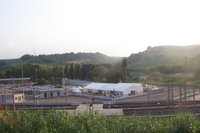Like in every large event, the fires pyrotechnicians have closed the challenges of the European People Festival carried out in Italy. An exceptional manifestation, me dispiace for the organizers, the will and the abnegation of hundred of volunteers who, proud of their country have guided manifesting. They are they that they work in the shadow, they are in every day contact and they instruct atleti/e the true vincitori of the Torneo. To speak about challenges with persons whom they make of the fratellanza, of the friendship between people, an art, is possible but, not necessary.
S.Vito Chietino it has not made to rinpiagere Italy like hospitality, acceptance and savoir to make. A good excess, in spite of the little reassuring news from the hearths of war Middle Eastern, has invaded inhabitants, manifesting, organizing, voluntary. Moral, if an event does good us to be and good because cannot more often repeat the event?
Come in ogni grosso evento, i fuochi pirotecnici hanno chiuso le sfide dell'European People Festival svolte in Italia.
Una manifestazione eccezionale, mi dispiace per gli organizzatori, per la volontà e l'abnegazione di centinaia di volontari che, orgogliosi del loro paese hanno guidato i manifestanti. Sono loro che lavorano nell'ombra, sono in contatto giornaliero e istruiscono gli atleti/e i veri vincitori del Torneo. Parlare di sfide con persone che fanno della fratellanza, della amicizia fra popoli, un'arte, è possibile ma, non necessario.
Rivediamo in una rapida carrellatta le nazioni partecipanti:
1) Aranda de Duero (Spagna),
2) Athone (Irlanda),
3) Ban Segeberg (Germania),
4) Cantanhede (Portogallo),
5) Dunoon (Scozia),
6) Ekenas (Finlandia),
7) Frederikssund (Danimarca),
8) Haarlem (Olanda),
9) Kaunas (Lituania),
10) Libramont-Chevigny (Belgio),
11) Loutraki-Perahora (Grecia),
12) Rezekne (Lettonia),
13) S.Vito Chietino (Italia),
14) Schifflange (Lussemburgo),
15) Szentendre (Ungheria),
16) Tarnow (Polonia),
17) Thouarsais Bouildroux(Francia),
18) Upplands Vasby (Svezia).
S.Vito Chietino non ha fatto rinpiagere l'Italia come ospitalità, accoglienza e savoir fare. Un eccesso di buonismo, nonostante le notizie poco rassicuranti dai focolai di guerra mediorientali, ha invaso abitanti, manifestanti, organizzatori, volontari. Morale, se un evento ci fa stare bene e buoni perchè non possiamo ripetere l'evento più spesso?
29 luglio 2006
European People Festival 2006: The End
EPF 2006: Upplands Vasby (Svezia)




Upplands Vasby is situated in an excellent position, it is only 20 Km from Stockolm and only 15 Km from the Arlamda Airport.Upplands Vasby has 37000 ihabitants.
The city is surrounded by many lakes such as Lake Norrviken, wich offers a naturalistic bike track, and Lake m'Iaren, where you can go along, by canoe, The Vikung Route, which is about 100 Km long and wich passes through places full of historical interest.
In 1952, Upplands Väsby municipality was formed out of the merging of the Ed, Fresta and Hammarby parishes.
At the start of the 1950s, there was a desire to make one large municipal district out of the three parishes. Many people were against the proposal at the time: none of the parishes wanted to be dependent on any of the others. Now we can see that the merger was a sensible decision. Upplands Väsby municipality is a good size to manage its own affairs and many mutual problems have been resolved through collaboration. Ed, Fresta and Hammarby still exist as church congregations. Right at the outset, it was not absolutely certain what the municipality was going to be called. Finally they decided on Upplands Väsby, because that was what the railway station was called.
New municipal coat of arms in 1961
The church in the centre symbolises the three old churches and the cog-wheel industries. The appearance of the coat of arms was finalised in 1961 when it was approved by the King.
EPF 2006: Thouarsais-Bouildroux -Saint Sulpice en Pareds(Francia)

THOUARSAIS is small country village that is situated in the heart of the "Bocage Vendeen". The main economic activity is still agriculture. The good feeling between Thouarsais and Saint Sulpice attracts and calls up from now on a good part of the villages in the district (canton). Saint Sulpice en Pareds is a natural and traditional agricoltural village. Since 1992, has rappresented France every year at the great european Meeting of the Festival.
EPF 2006: Tarnow (Polonia)
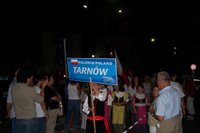
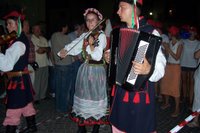


Tarnow is located at the beginning of the Carpatian Mountains. It has the biggest number of historic monuments in southern poland. The old city of Tarnow is spoken of as "Pearl of Renaissance" by art conoisseurs: in the epoch of renaissance it was one of the most beatiful towns in Poland. It was the fourth largest Jewish community in former Galicia, so there are many remnants of Jewish history.
Sacral sites and artefacts are the most significants of all the Tarnow region's attractions. The Tarnow Seminary is Known as the greatest Christian Seminary in the world.Also, the oldest Christian Diocesan Museum in Poland is located in Tarnow.
EPF 2006: Szentendre (Ungheria)

Szentendre is the largest settlement of the Danube Bend, located north of Budapest along road 11, on the right side of the Danube. The quiet town has 23000 inhabitants. By car, the city can be reached in 20 minutes from Budapest, and in about 40 minutes with the communal train (HÉV - from Batthányi tér). As a result of the beautiful surrounding and warm climate, citizens of Budapest and many people have built small weekend-houses on the hills and mountainside of the area.
Szentendre is the city of arts and museums. The town hosts the famous Open Folklore Museum and one of the best known museums of the country, the Kovács Margit Museum. In addition to these, there are 16 more museums and galleries to present the rich arts and cultural life of the city.
In the neighborhood of Szentendre, Leányfalu, Visegrád and Szentendrei-island are the ideal place for those looking for swimming pools and water sports in general. In the past years, several riding schools and arenas have been opened in the proximity of the city.
EPF 2006: Schifflange (Lussemburgo)


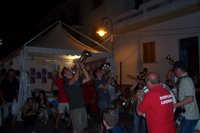

A small town of about 8500 inhabitants situated at the very south of Luxembourg. It is one of the most ancient agglomerations of the Grand-Duchy of Luxembourg. It is not only one of the oldest towns of the country and one of the smallest. Talking about the population, we count 35 % of foreigners coming from 39 nations.
For a long time the development of the town was very slow until it stopped definitely in 1742. Then, after the destruction of the church by Napoleon's soldiers, after a big fire in 1862, the started to grow step by step because of the systematic exploration of the iron are and the construction of blast furnaces.
Finally, in 1875 a petition counting a 1000 signature address to the parliament gave Schifflange the title of "Indipendent town". Unfortunately the e world wars provoked a stop in the town's developed. With the end of the war a new economic boost started and Schifflange thanks to her legendary industrious population, soon became a flourishing commercial and industrial center, open to everything and everyone.
EPF 2006: Rezekne (Lettonia)



Rezekne
Historical aspects of the development of Rezekne town - building structure has been explored by architect Ms R. Zandberga on whose study this part of report on town's development during 13 - 17 centuries is based.
The township along with a stone walled church was destroyed during a Livonian war. Rezekne comes under the rule of Poland in 1582. A new town with 24 housing blocks for Poles is developed next to the old township. A new wooden church is built in the place of the previous one. Planning of Rezekne during that period has defined the place of the middle part of the present Latgales street. Newly built Ludzas road becomes a backbone of town' s composition. The town continues to grow further along this road in eastern direction. A new parish church is built in 1685 along with a drinking place built later.
Rezekne is presented with Magdebourg rights widely used in Poland in 17th century.
Rezekne is included in Russian Empire after the first division of Poland in 1773. New Rezekne plan is ratified in 1778 and it provides for a double increase of the town's territory with adjustments to existing building. Newly projected rectangular territory of the town is situated on the left bank of Rezekne river between two brooks flowing into the river.
St Petersbourg - Warsaw highway was built through Rezekne in 1836 and a new part of town was projected because of that. It found its place on the right bank of the river along the eastern side of the highway, making it the main street of so called "new town" (present Atbrivoshanas alley).
Rezekne became a cultural and economic centre of Latgale with a foundation of the state of Latvia in 1918.
EPF 2006: Loutraki-Perahora (Grecia),
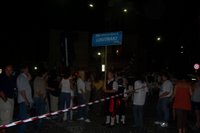

Loutraki is one of the most important spas in Greece. The town has been built on an excellent grid plan, which includes wide avenues, squares and a well-known waterfront. Hotel availability is in the vicinity of 5,000 beds-more are offered in private lodgings. A casino used to operate in Loutraki before World War II, but its operation was suspended until a new one opened in 1995.
Loutraki is considered Greece’s most ancient bathing resort. The first written reference to the city of Loutraki is in the "Hellenica", a book by the Athenian historian Xenophon (431-351 bc). He referred to "Thermae" (the ancient name of Loutraki which derived from "Thermia Artemis", the protector goddess of therapeutic mineral waters), mentioning that the Spartan king Agesilaos camped there during the Corinthian war (395-387 bc). Located in a strategic geographical position (a connecting point between Athens and the Peloponnese), at the foot of Gerania Mountain, the city was first colonized by the Corinthians in 750 bc. There are also historical references that around 146 bc, when the Romans took over the city, General Sulla was cured in its spa waters.
The therapeutic properties of the waters of Loutraki were also aknowledged in medieval times--possibly even before 1345 ad, when Byzantine Emperor John Cantacuzene built the church of Aghios Andreas, which survives until today. The number of churches built during the Byzantine era proves the importance of the city and its development through the ages. The saline waters of Loutraki (30-31°C) are used both internally (drinking and inhalation) and externally (baths) for curing dyspepsia, arthritis and liver ailments. The bottled water of Loutraki, with a strong presence of magnesium, is considered the best in Greece and can be found under several brand names that all feature the word Loutraki.
Loutraki was officially characterized as a spa in 1925. The Loutraki- Perachora Municipality was established in 1934. The ancient site of Perachora, with its famous 8th-century bc Heraion, temple of Hera, lies 15 kilometres north of Loutraki, at the tip of the peninsula, with the Lake Vouliagmeni lagoon, another six kilometres out.
EPF 2006: Libramont-Chevigny (Belgio)

The comune of Libramont Chevigny (about 8250 inhabitants) is situated in the area rich in forest and uplands in the region of Ardennes. The town, built in 1858 with the installation if a railway system, has officially born in 1900 becoming an administrative centre. More recently, a fusion was made with the ancient Ban de Chevigny, from wich the city takes its name.
Chevigny rapresented,Till the french revolution, a large fiscalrule under the service of Lothaire II, in the 9th century, of the Countess Richilde de Hainant, in 11th century, and of the Abbey of Saint-Hubert, after 1071.
In spite of this prestigious past, the city didn't preserve clear historical evidences of it.Thanks to its position on crossroads of important lines of communications, Libramont Chevigny is prevalently a trading and amministrative centre
equipped with modern infrastructures.
EPF 2006: Kaunas (Lituania)





Kaunas with nearly 400 thousand inhabitants is one of the most significant cities of Lithuania. It is not only a city of old traditions, but also a large centre of business and industry. It can also lay claim to be a city of young people with over 35,000 students studying at one of the seven universities here.
Kaunas was always fated to become an important historical and cultural city in Lithuania. In 1408, Magdeburg rights were granted to the city of Kaunas by the privilege of Vytautas the Great. During the early 20th century, governed by its first Burgomaster Jonas Vileisis, Kaunas was the home of the Lithuanian Government and the capital city; a period considered by many as the golden age of the city. However, history tells us that even before this date, the city, situated at the confluence of the rivers Neris and Nemunas, experienced many other periods of great prosperity and national importance.
Hundreds of years of cultural heritage is preserved in the historical and architectural monuments, museums, theatres, art galleries and churches of Kaunas. In Kaunas we are proud of the importance that our people have played in contributing towards making the rich cultural, historical, and academic tapestry that is Lithuania.
For business and investors, our city offers friendly, open, and creative space for partnerships and co-operation. We can provide you with clear, practical advice and guidance to doing business here, as well as access to a highly educated and skilled labour force and a large selection of buildings and development parks for you to start and grow your business.
EPF 2006: Haarlem (Olanda)

Haarlem is a municipality and a city in the Netherlands, capital of the North Holland province. The city is located by the river Spaarne, about 20 km west of Amsterdam and near the coastal dunes. It is the center of a flower-growing district and the export point for bulbs, especially tulips.
The municipality of Haarlem also comprises the village of Spaarndam.
The motto of Haarlem is Vicit vim virtus, which is Latin for Virtue conquered force.
EPF 2006: Frederikssund (Danimarca)



Frederikssund With 17,000 inhabithants, rises on the area of the Noedsjaelland's fjords,where Vikings lived in the past. The city was named Frederikssund in 1650 and the following years it developed and became a true city. Every year, a big stage is put up where the ancient Viking exploit are recalled. This has allowed the reconstruction, in 1993, of an authentic Viking Village taht makes the city a tourist destination. The region of Horsherred, where Frederikssund rises, has been the residence of the most important men of Denmark, who left beatiful monuments. Two of them are the Selso castle, from the 16th century and the Jaegersprits Castle that still preserves an ancient aspect because of its original furniture. One can visit the J.F. Willumsen Museum and also the Dolls Museums. The area offers various sporting and recreating activies and numerous cultural events. Beatiful woods surrounds the Frederikssund area. One of them is the Nordskoven Woods, where there is the oldest oak tree of Northern europe.
EPF 2006: Ekenas (Finlandia)



Ekenas
The southern point of finland is the pearl of Finland.The wonderful landscape, vast archipelago areas is combined with a rich and fashinathing cultural history. The magnificient archipelago, unspoiled woods and small communities offer unique opportunities for adventure and recreation. The old iron works communities laid the foundation for the Finnish industry. The old setting are carefully preserved as museum areas. The distance from Helsinki is about 80 Km. The region has a populationof approximately 40,000 inhabitants. In the area there are two town (from west to east) Hanko was founded in 1874, is a maritime, industrial and tourist town. It has about 12000 inhabithants. Ekenas (in finnish tammisaari), an idyllic small townon the coast of Western Uusimaa - receveid its city rights as early as 1546 from Swedish King Gustavus Wasa. The town has grown on a narrow peninsula that stretching as far as 20 Km, with around 1300 islands. It has preserved the caracter of an idyllic small town, with its many garden andthe wooden buildings of the old town. The medieval castle of Rosemborg is situated 15 Km from the centre.
EPF 2006: Dunoon (Scozia)


Situated in west coast of Scotland in the country region of Argyll and Bute, Dunoon is the major town of the Cowal Peninsula.An area lies between Loch Fyne and Lock Long. Dunoon, the capital of Cowal, lies within an area of outstanding natural beauty, on the borders of Scotland's first National Park - the Lock Lomond and Trossachs National Park. The population of Dunoon is approximately 12,000 people, wich includes some 4,000 inhabitants of smaller surrounding towns.
It is the principal holiday resort town of the Cowal Peninsula, the main street boasting a variety of shops and restaurants which serve a variety of Scottish and international cuisine. During the tourist season it is possible to enjoy a voyage on the World's last original paddle steamer "WAVERLEY" wich visits many of the islands and other small towns of the River Clyde.
EPF 2006: Cantanhede (Portogallo)



Cantanhede is a municipality of Portugal, located in the district of Coimbra. The town is located halfway between the cities of Coimbra and Aveiro.
It is a well-preserved urban area elevated to city status, with an urban population of 8,000 and a population of 12,000 in the municipality. It is home to a number of large and elegant homes, dating back to the 19th Century.
Cantanhede is growing fast, and the inauguration of the C.C. Rossio (a large shopping centre) helped to boost the area's economy. Traditionally a major agriculture center, Cantanhede is at the heart of the Bairrada Wine District. The town is home to Biocant, a modern biotechnology park, aimed to create value in business initiatives by developing and applying advanced life sciences knowledge and technology. This park is attracting biosciences companies to Cantanhede, and has the scientific background of the University of Coimbra and Aveiro University, both associated entities of the project.
EPF 2006 : Ban Segeberg (Germania)

Bad Segeberg is a town of 16,000 inhabitants, located in the state of Schleswig-Holstein, capital of the district (Kreis) Segeberg. It is situated approx. 50 km northeast of Hamburg, and 25 km west of Lübeck.
Bad Segeberg, which is officially certified as a climatic health resort and spa, is know as the town of the Karl-May-Festival. Situated at the doorstep of the so called " Switzerland of Scleswig-Hollstein", it is surrounded by the hilly landscape of forests characteristic of Schleswig-Holstein.
The famous landmark of Bad Segeberg is the "Kalkberg" (limestone hill).
Bad Segeberg can look back at 850 years of variety town history.Inspiread by a monk, the Emperor Lothar III had the "Siegesburg" built at the top of the Kalkberg in 1134. A church and a monastery were built at its bottom.The oldest buiding preserved until today is the community centre of old segeberg which is the home of an interesting folk museum today. Bad Segeberg is widely known as the "rider's capital" and organizes the Swhleswig-Holstein horse show for all the riding clubs.
EPF 2006: Athlone (Irlanda)



Athlone located in the centre of Ireland is a thriving town on the banks of the River Shannon. It is an ideal destination for a holiday, weekend break or business trip. The town offers extensive choices in quality accommodation, restaurants, shops, pubs, sport & leisure activities and entertainment.
At the heart of Athlone, both geographically and historically, is the castle. The military history of the town dates back to antiquity. The ford of Athlone is strategically important, as south of Athlone the Shannon is impassable until Clonmacnoise (where the Esker Riada meets the Shannon), and north is Lough Ree. In 1001 Brian Bóruma led his army from Kincora into the town, his fleet sailing up the river via Lough Derg to attend the gathering.
During the wars that wracked Ireland in the seventeenth century, Athlone held a vital position, holding the main bridge over the River Shannon into Connacht. In the Irish Confederate Wars 1641-1653, the town was held by Irish Confederate troops until it was taken late in 1650 by Charles Cooote, who attacked the town from the west, having crossed into Connacht at Sligo.
Forty years later, during the Williamite war in Ireland, the town was again of central strategic importance, being one of the Jacobite strongholds on the defending their position after they had retreated west after the battle of the Boyne. At the first battle of Athlone in 1690 the Jacobite forces of Colonel Richard Grace repelled an attack by 10,000 men lead by Commander Douglas. The following year the Siege of Athlone saw a further assault in which the troops of King William III eventually prevailed against the outnumbered defenders.
The current bridge was built in the 19th century to replace the old bridge which was becoming dangerous to the increasing volume of traffic. Originally the bridge had a moveable section which was decomissioned in the early 20th century. This is the reason for the large footings and metal railings on the Connaught side.
Clonmacnoise, a famous monastic site with a round tower and spectacular Celtic crosses, lies on the east bank of the Shannon some 14 km south of the town (24 km by road). Clonmacnoise itself was an important ford since antiquity. The Normans built a castle there to defend a bridge.
During the 19th century, the Board of Works built a weir wall south of Athlone to improve the navigation of the river. During the summer foolhardy young men attempt to walk across the wall from Connaught to Leinster. The river at this location has a very strong current and many people have drowned attempting to swim the Shannon here.
Other fortifications include the ruins of a battery just to the north of Athlone (in an area now a nature reserve) and a large artificial hill called "The Batteries" upon which council housing has been built. On the Leinster side of the town, remains of defences built in the 19th century to help thwart a French attack still exist, particularly around the offices of the Town council. The Connaught side was defended by a fosse which no longer exists.
Europenan People Festival: Aranda de Duero (Spagna)




Aranda de Duero is a Spanish town and municipality in the south of the province of Burgos. It has a population of roughly 32,000 people. The closest airport is in Valladolid.
Aranda de Duero is the capital of the Ribera del Duero wine region. The town is unique for having wine cellars that interconnect below the streets of the town centre. Wine clubs (peñas) celebrate special events in these cellars.
Aranda de Duero is at the junction of several transport routes across Spain. The N1 autovia (or A1 as it's now known) runs north / south by Aranda, along which visitors and import/export goods travel between Madrid and the south coast. Another important road running east to west connects Portugal with important cities on the way (eg Zamora, Valladolid, Soria) and the east coast. Its situation at the juncture of these routes has lead to Aranda de Duero acquiring a growing recognition and function as a business centre. Several multinational corporations, such as Michelin and Glaxo Smith Kline have large facilities in the area.
A dish called Lechazo is a local speciality. This is roast baby lamb and is usually served with a basic salad and lots of "torta" bread for dipping in the meat juices.



